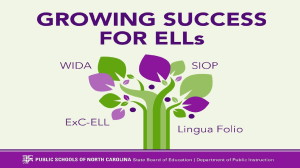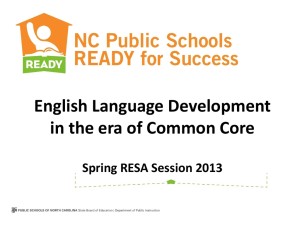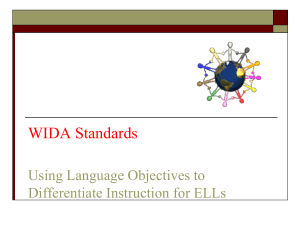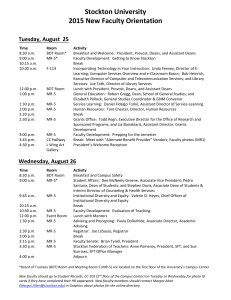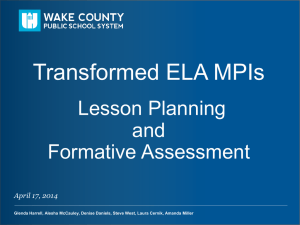WIDA Advanced Presentation
advertisement
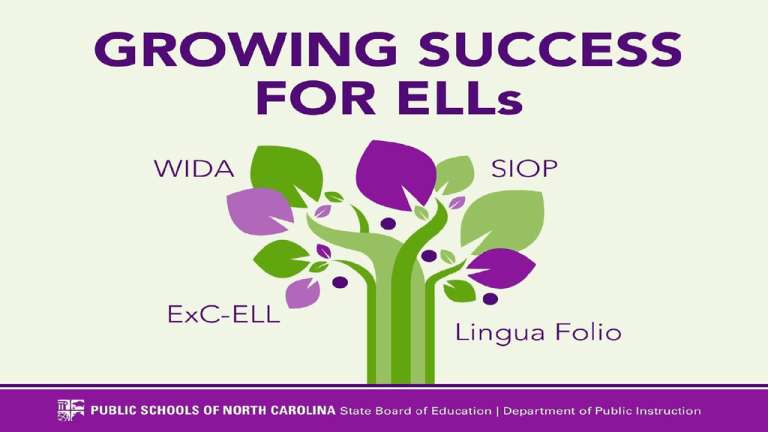
Introductions Kelsie Berg, SIOP Coach kelsie.berg@bcsemail.org Revae Bostwick, ESL Lead Teacher revae_bostwick@nccs.k12.nc.us Nadja Trez, DPI Consultant nadja.trez@dpi.nc.gov Ice Breaker - 4 Corner Activity 1) Go to the corner marked with your ideal vacation spot 2) Discuss the following types of information: * names, current role(s) in district, * teaching experience * attendance at previous WIDA conferences * reason for attending this conference, etc. 3) Report out with a group identity statement once finished. Today’s Objectives 1. Evaluate the elements of WIDA’s English Language Development Standards through interaction. 1. Interpret WIDA’s Guiding Principles of Language Development. 1. Understand how WIDA, CCRS (College and Career Ready Standards), & Academic Language fit together and develop MPIs specific to our instructional goals. Logistics * restroom locations * break times * wifi passwords * group norms Today’s Agenda 7:30 - 8:30 Registration/Breakfast 8:30 - 10:00 Opening Session 10:00 - 10:15 Break 10:15 - 12:00 Concurrent Sessions 12:00 - 1:00 Lunch 1:00 - 2:30 Concurrent Sessions 2:30 - 2:45 Break 2:45 - 4:00 Concurrent Sessions Schedule Overview Day 1 Review of WIDA basics Develop MPIs based on students’ language performance Day 2 Create formative assessments utilizing the created MPIs Utilize data to make adjustments to district or school LIEP plan Day 3 Collaboration with content area teachers and getting WIDA buy-in -- why we all have to be language teachers Sharing with colleagues in our districts Rank your WIDA knowledge level Survey “Questions” PollEv.com/eslcc 1. I can explain the 6 language proficiency levels. 2. This is what I know about the WIDA performance definitions... 3. I can explain the differences among vocabulary usage, language forms & conventions, and linguistic complexity. 4. I can utilize WIDA standards to develop lesson plans. 5. I am able to develop MPIs for content standards based on students’ language proficiency levels 6. I can recognize whether WIDA standards are being utilized within instruction. What is WIDA? Each participant has a (blue) card or a (yellow) card containing a question or response pertaining to WIDA. Find your match and hold up your cards briefly to let us know you have been successful. ^_^ WIDA ELD Standards So many layers to consider! WIDA’s Guiding Principles of Language Development Cards with one guiding principle each are on each table. Participant 1 reads the card. Participant 2 responds to the card. Participant 3 adds an additional response. Participant 4 summarizes what has been said. (Add additional responses before the summary as needed based on the number at your table.) WIDA Components * Proficiency Levels * Performance Definitions (old & new) * Vocabulary Usage, Linguistic Complexity, Language Forms and Conventions * Can Do Descriptors * Components of new MPIs in the 2012 handbook Proficiency Levels Performance Definitions At a given proficiency level, what the ELL student will process, understand, produce, or use. (Page RG44 in the 2007 Edition) New Performance Definitions Receptive Productive p. 8 in 2012 version p. 9 in 2012 version Your Turn! Take the speaking and writing performance definition elements and arrange them appropriately according to proficiency level. Speaking Rubric Found on p. RG-55 in the Resource Guide of the 2007 WIDA Standards handbook. This is the rubric that WAPT and ACCESS administrators should be utilizing to evaluate responses. Writing Rubric Found on page RG-56 in the 2007 WIDA Handbook Resource Guide. ACCESS writing domain is evaluated via this rubric. Upon Review of the Rubrics…. DISCUSS: 1. What is the purpose of the rubrics? 2. How are these useful and how do you use them in your districts? 3. What are the implications for ELLs? please discuss & then share out your table responses in a few minutes. Vocabulary Usage (Specificity of word or phrase choice) • • • • • General, specific, and technical language Multiple meanings of words and phrases Formulaic and idiomatic expressions Nuances and shades of meaning Collocations Linguistic Complexity vs Language Forms & Conventions DISCOURSE LEVEL Linguistic Complexity ★ ★ ★ ★ ★ * quality & variety of oral and written text amount of speech/written text structure of speech/written text density of speech/written text organization & cohesion of ideas variety of sentence types SENTENCE LEVEL Language Forms & Conventions * types, array, & use of language structures ★ types and variety of grammatical structures ★ conventions, mechanics, & fluency ★ match of language forms to purpose/perspective Sociocultural Context The sociocultural contexts for language use involve the interaction between the student and the language environment, encompassing the… • Register • Genre/Text type • Topic • Task/Situation • Participants’ identities and social roles Bringing together all the aspects of Academic Language Stepping up the language! Let’s practice! What are the instructional implications of moving students up the scale? Share challenges and celebrations of how you increase the use of the upper level academic language features. Can Do Descriptors • More specific to grade level than language performance definitions • Focus more on academic tasks • Detailed by language domain What are the instructional implications of utilizing the Can Do Descriptors? How do you use them? Inside-Outside Circle 1. Think about a skill you have and can do well. 2. Form an inside & outside circle following facilitators’ directions. 3. When the music stops, discuss your skill with the person standing opposite from you. 4. Identify reasons why the partner is able to do that skill & determine supports that might help you be able to do that skill right now. A Reflective Moment What about WIDA has been an important reminder for you today? Click on this link: PADLET to share your thoughts. 2012 WIDA MPI Format (Overview) Our tool to optimize learning! How do we create an MPI? 3 components of an MPI * additional components from 2012 WIDA handbook Support Examples What is transformation? (in relation to an MPI) As the name implies, transformation simply means to change or convert something. And in the case of MPIs, transformation occurs when we change one or more of its three elements: the language function, the content stem, or the instructional supports to make it specific to our own use within our own lessons. Examples of transformed MPIs http://www.livebinders.com/play/play?id=1089921&backur l=/shelf/my Links to the Standards: Math ELA Science Social Studies What guides MPI construction? Process for Developing MPIs ALSO: Assessment & Feedback Practice & Application At your table discuss possible MPIs that could be created based on the following information & select 1 person from your table to share with the whole group. • • ELD Standard: Language of Science Content Standard: Explain why Earth sustains life while other planets do not based on their properties (including types of surface, atmosphere and gravitational force) and location to the Sun • • Cognitive Function: your choice Language Proficiency Level: Level 3 Work with a partner to develop a strand of MPIs. Links to NC Standards: Math Science ELA Social Studies http://www.jeffzwiers.org/tools--resources.html How do the pieces fit together? What image symbolizes the way you see WIDA Standards, College & Career Ready Standards, and Academic Language blending/fitting together? ** take some time to process this & then work with a group of 3 - 4 people to come up with an image that represents the way in which you see them all fitting/working together Q & A; Wrap-up Day 2 Day 1 Review of WIDA basics Develop MPIs based on students’ language performance Day 2 Create formative assessments utilizing the created MPIs Utilize data to make adjustments to district or school LIEP plan Day 3 Collaboration with content area teachers and getting WIDA buy-in -- why we all have to be language teachers Sharing with colleagues in our districts Today’s Agenda 8:00 - 10:15 Concurrent Sessions 10:15 - 10:30 Break 10:30 - 12:00 Concurrent Sessions 12:00 - 1:00 Lunch 1:00 - 2:30 Concurrent Sessions 2:30 - 2:45 Break 2:45 - 4:00 Concurrent Sessions Today’s Objectives 1. Develop formative assessments to authentically gauge academic language and content knowledge based on the MPIs that were created. 2. Analyze data and design actions based on data implications. Bridging Yesterday’s Work with our NEW DAY! •What image symbolizes the way you see WIDA Standards, College & Career Ready Standards, and Academic Language blending/fitting together? •Time to share! FORMATIVE ASSESSMENT Construct a circle map that gathers what you know about formative assessment as a table group. monitors student learning formative assessment In your table groups, assign sections of the article, “Formative Assessment: What Do Teachers Need to Know and Do?” by Heritage, mark the text individually and share with your group after reading. Decide if this information should be added to your group’s circle map (in a different color). Share new/added info with the whole group. www.flareassessment.org Effective Use of Formative Assessment In order to use formative assessment effectively with ELLs, teachers must be cognizant of students’ needs in content area learning and language development. source: WestEd Laura Alvarez, Sri Ananda, Aida Walqui, Edynn Sato, Stanley Rabinowitz Formative Assessment Examples http://wvde.state.wv.us/teach21/ExamplesofFormativeAssessment.html Observations - keep a notebook of only observations 3 - 2 - 1 Exit Slips Reading Response Logs Questioning based on Bloom’s Taxonomy (Stick Pick App) Checklists based on Can Do Descriptors, Linguafolio, WIDA rubrics Self-evaluations Individual Whiteboards Grades 1 - 3 Language Strand Formative Assessment / Staff Communication www.toondo.com SIOP Walkthrough Google Form Are your formative assessments IDEAL? I - Integrated D - Dynamic E - Enlightening A - Attainable L - Linked source: Wisconsin Center for Education Research (FLARE) www.flareassessment.org Take a moment to evaluate your formative assessments using the IDEAL Formative Assessments Rating Tool. Now What? What realizations did you come to after evaluating your formative assessments? What resources do you need to help you incorporate IDEAL formative assessment? Example of Using Formative Assessment in PLCs •Analyzing student work for evidence of outcomes by standard. Revisit Your MPIs Based on your reminders about formative assessment, brainstorm some authentic ways to assess your MPI strand. Let’s examine the data Data Analysis Sequence Guidance for the Data Analysis Process Step 1: Pose Q(s) - What questions will be addressed? Step 2: Slice and visualize - How will the data be visualized? Step 3: Observe - What does the data reveal? Step 4: Hypothesize - What meaning does the data have? Step 5: Strategize - What actions will be taken? ** See, “Data Analysis Cycle Summary and Questions”** What were the steps again? Step 1= Step 4= Step 2= Step 5= Step 3= My Question (purpose): What areas should I target to better facilitate language development for my 4th grade students? 1. What is the purpose of analysis? ACCESS LISTENING & READING RESULTS Grade 2. What data do we have? Soc & Inst Lang. Arts Math Science Soc. St. 4 100% 50% 75% 44% 55% 4 100% 50% 58% 33% 67% 4 100% 92% 75% 89% 89% 4 50% 25% 33% 55% 44% 4 83% 83% 83% 67% 67% 4 100% 58% 83% 44% 78% 4 83% 78% 100% 100% 83% 4 83% 75% 50% 44% 78% 3. What patterns do we see in the data? 4. What questions and assumptions are raised by our data? 5. What might be contributing to these patterns? 6. What steps might we take to combat these potential contributing factors? What does the data tell me? What patterns do I observe? What may be some contributing factors? What additional information do I need? What steps should I take from here? Hypothesis: ● What is one hypothesis we could make based on this data? ● What is a strategy that could be incorporated based on your hypothesis? Strategy: Grade Linguistic Complexity Vocabulary Usage Language Control Linguistic Complexity Vocabulary Usage Language Control LANGUAGE ARTS & SOCIAL STUDIES MATH & SCIENCE 4 3 4 3 4 3 3 4 3 3 2 3 4 3 4 4 4 3 4 3 3 4 2 3 2 3 2 3 4 4 4 4 4 3 3 4 3 4 3 3 3 2 4 2 2 1 3 2 2 4 3 3 3 3 2 2 ACCESS Writing Scores A District Example •ESL teachers charted and graphed the percentage of reading scores at 4+ by grade level for 2 consecutive years. •Using the visual, they recorded observations and hypotheses. •Afterwards, next steps were recorded. •Finally, “Building Blocks” were considered and shared with building administrators and instructional coaches. Next Steps- Tool for Implementing Strategies How about your district? •How has data been used to drive instruction? It’s Data Time! Apply the same process to analyze data from YOUR district or school. Once completed, we will share our findings in a Padlet (link on next slide). What were your findings? • What were your strengths? • Which content areas were weaker than others? • Were your students better at academic vocabulary than language forms and conventions? • What types of professional development should you provide your teachers or administrators this year? • What strategies should you implement to improve any weak areas? • Click on this link: PADLET to share your thoughts Activity - 15 Essential Actions Review of data & its implications Information about student background, including linguistic and content abilities, is key to plan and deliver instruction to optimize opportunities for learning (Tomlinson, 2003; Fairbairn & Jones-Vo, 2010). Reflection How will our data discoveries change our practice (district, clasroom, and/or school)? Please record thoughts on chart paper (2 per table). We will do a gallery walk after completion. : ) Let’s Revisit Our MPIs and Formative Assessment Now That We’ve Reflected on Data Do the MPIs correlate with what actions we need to take now that we are more informed of our district’s needs? Using Bloom’s, Edynn Sato, etc. documents, revise the constructed MPIs using the templates. Stop and Jot How has the awareness reached through data analysis shifted your perspective when looking at MPIs and formative assessment? Has it? Why or why not? Turn and Talk from Your Stop and Jot! Day 3 Day 1 Review of WIDA basics Develop MPIs based on students’ language performance Day 2 Create formative assessments utilizing the created MPIs Utilize data to make adjustments to district or school LIEP plan Day 3 Collaboration with content area teachers and getting WIDA buy-in -- why we all have to be language teachers Sharing with colleagues in our districts Today’s Agenda 8:00 - 10:15 Concurrent Sessions 10:15 - 10:30 Break 10:30 - 12:00 Concurrent Sessions 12:00 - 1:00 Lunch 1:00 - 2:30 Concurrent Sessions 2:30 - 2:45 Break 2:45 - 4:00 Concurrent Sessions Bringing It All Back Home Individual Reflection Time with the Essential Actions ACTION 1 Guiding Questions 1. How do the resources and experiences of students impact their engagement with the curriculum and their learning? 2. What might you do to learn more about students’ resources and experiences? 3. What are some examples of how you might incorporate students’ resources and experiences into the curriculum? Participant Response So . . . Guiding questions for discussion of responses • What stood out to you in your reflection? • So what are the implications? • Then what action is needed? Please share with your group. A Huge Responsibility for ALL! Academic achievement—for all students—requires mastering academic language, and since students are primarily only exposed to the academic language of science, or social studies, or any other content area in those classes, this emphasizes the imperative that all teachers are responsible for helping students develop academic language in their own subjects. It’s not going to happen elsewhere. Collaboration Is Key! How do you currently collaborate with your colleagues to meet the needs of your ELLs? Schoolnet Resources https://buncombe.powerschool.com/ad min/home.html “Can Do” Sharing http://widaatwcer.blogspot.com/2012/05/can-do-descriptors-in-grades-3-5.html Dialectical Journal What are your thoughts? • Take one of the quotes and write a response. • Pass the paper to the left. • 2nd person responds to and builds upon the 1st response. We are all language teachers! “Language and the Common Core State Standards” Leo van Lier, Monterey Institute of International Studies Aída Walqui, WestEd What might you need to share or remind your district of from the article? “it is the differences in the ways people use language to accomplish goals and conduct their relationships that may have the most powerful consequences for student interactions in the classroom” source: WestEd What comes to mind when you hear “Academic Language?” Write Around Activity 1. One person writes 1 word associated with “academic language.” 2. Pass the paper to the person on the right and he/she writes an additional word. 3. Continue passing the paper around your table until time has been called. Academic Language and Literacy http://www.jeffzwiers.org/index.html Teachers don’t need more strategies, they need to know more about language acquisition & development. Why Do Teachers Need to Know More About Language? Teacher as …. 1) Communicator 2) Educator 3) Evaluator 4) Linguist 5) Socio-culturalization What is the language of the content areas? (a.k.a. disciplinary literacy) Reading Instruction Suggestions for ELLs Structured Conversation Practice http://www.jeffzwiers.org/interaction.html Additions to the Language of English Language Arts? 5 Interdependent Strands of Math Planning and Delivering Effective Math Instruction 1) Early, explicit, and intensive instruction and intervention in basic math concepts and skills 2) Purposeful academic language instruction •polysemous words •complex phrases •language functions: explain, solve, discuss •passive voice 3) Academic language support • content of the question; elements of word problem; function of language What would cause difficulties for ELLs? Math Paired Conversation Protocol http://www.jeffzwiers.org/interaction.html Science language functions Teaching Students to “Speak” Science Conversation Analysis Tool 1. Do conversation turns build on previous turns to build up an idea? 2. Do conversation turns focus on the knowledge or skills presented in the objectives? Rating Criteria: 4 - ½ or more turns do so clearly & concisely 3 - ½ or more turns do, but not clearly 2 - few turns do 1 - no turns do adapted from the work of Kenji Hakuta, Jeff Zwiers and Sara Rutherford-Quach, Stanford University What from the “Constructive Conversation Skills Poster” could we incorporate for an academic conversation in science? The Language of Social Studies Disciplinary Thinking Lens- History How would vocabulary and expressions change when discussing this event from the British perspective? What may be missing? * presentation orally & in writing * content context * frequent exposure and practice over a long period of time * conversation practice with learners w/higher language skills * scaffolding * rigorous academic language (“juicy text”) * constructive feedback on language development What feedback would you provide? My metaphor for “A poison tree” is - wrath is like the seed was hiding into an apple, nobody can see it. Wrath means very angry, very angry to somebody. It may happen on you friend or you rival. But you can’t see that just from the outlooking because it was hiding in your heart and just you know that. so I use “the seed was hiding into an apple, nobody can see it.” First of all, I made this comparison because it is the good way to show and make people to understand the word of “wrath.” Besides, then I can spend this metaphor to express my internal world. In my heart there has many wraths. Something is about the teacher; something is about my relative; and something is about love. But I almost forget it, expect one thing was happened in XYZ High School. Bringing It All Back Home Our Past Three Days- What Now? • WIDA • MPIs • Formative Assessment • Data revelations • Academic Language Who, what, when, where, and how will these things be addressed in your district for the 2014-2015 school year? Let’s use- Action Plan: Creating a SMARTEST Plan to plan next steps. Ready, Set, Go! Time for ACTION! Let’s use- Action Plan: Creating a SMARTEST Plan to plan next steps. Final Thoughts Kelsie Berg, Buncombe County SIOP Coach Revae Bostwick, Newton-Conover City Schools ESL Lead Teacher Nadja Trez, ESL DPI Consultant References Developing Content Area Literacy, http://www.sagepub.com/upm-data/34121_Section1.pdf Fillmore, L. W., & Snow, C.E. (2002) What Teachers Need to Know about Language Francis, D.J., Lesaux, N., Kieffer, M., & Rivera, H. (2006). Practical Guidelines for the Education of English Language Learners. Lemke, J.L. (1990). Talking Science: Language, Learning, and Values. Scarcella, R. (2003). Academic English: A Conceptual Framework Sato, Edynn. Language for Achievement. http://www.cde.ca.gov/sp/el/er/documents/achievementlang.pdf Walqui, A. (2003). Conceptual Framework: Scaffolding for English Learners. Zwiers, Jeff. Academic Language and Literacy. http://www.jeffzwiers.org/index.html Linguafolio self-assessmenthttp://esllfpilot.pbworks.com/f/LFGridNCES.pdf
